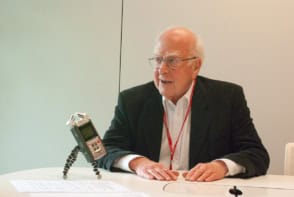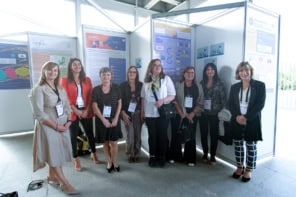Tushna Commissariat reviews Bombshell: the Hedy Lamarr Story, directed by Alexandra Dean

Immigrant, actor, producer, inventor, war-time fundraiser, feminist and a woman vastly ahead of her time – that’s Hedy Lamarr. A certified Hollywood movie star often dubbed “the most beautiful woman in the world”, and a bona fide ingenious engineer with a patent under her glitzy belt, Lamarr was a constant contradiction. To anyone discovering her today, it would seem as though Lamarr was misjudged, dismissed and valued only for her beauty. Lamarr’s inspiring and unconventional life – a heady (if you will excuse the pun) mix of sex, science, fame and misfortune – is perfectly brought together in the biographical documentary film Bombshell: the Hedy Lamarr Story.
Written and directed by Alexandra Dean, the film spans the entirety of Lamarr’s life, from her affluent and cultured youth in Vienna, to her path to fame and fortune in Hollywood, going into her many films, six marriages, three children and self-imposed seclusion towards the end of her life, before her death in 2000. Dean, who spent years covering innovation and technology for Bloomberg Businessweek, couldn’t help but notice the lack of female inventors being profiled. While trying to find such a figure, she read Hedy’s Folly by Richard Rhodes, and thought “Bingo – here is the role model everyone thinks doesn’t exist. And she’s a movie star! I knew it had to be my next project.”
A particularly interesting feature of Bombshell is that the film is largely narrated by Lamarr herself. In her search for interviews of Lamarr, especially ones where she talked about her research, Dean reached out to “every living journalist who had ever done an article on her”. She lucked out with journalist Fleming Meeks, who had interviewed Lamarr in 1990 while working for Forbes, and still had three tapes of their conversation. “It was a turning point for the film. We ripped up the film we had, and started all over again,” says Dean. “She took over as narrator, and it was like she was suddenly directing the film.” The film also includes extensive input from Lamarr’s children, son Anthony Loder and daughter Denise Loder; famous friends and colleagues such as Mel Brooks and Robert Osborne, and many others.
Born in Vienna in 1914, Hedwig Eva Maria Kiesler was the daughter of assimilated Austrian Jews. Although a bank clerk by profession, Lamarr’s father had a healthy interest in technology – the pair would go for walks around Vienna and he would point out to the young girl how a tram or a power plant works, sowing the early seeds for her curiosity. “Maybe I came from a different planet…who knows?” says Lamarr with a laugh as she talks to Meeks. “But whatever it is, inventions are easy for me to do.” At five years old, Lamarr took apart and put back together a small music-box – rather touchingly, her son Loder shows the very same box off in the film.
Despite her talent and love for science, by the time she was 16, Lamarr was considered so beautiful that she couldn’t possibly pursue any other career than acting. There is a certain ironic dichotomy in this – that Lamarr’s beauty was seemingly so extreme that it somehow hobbled any hope of her being a scientist, despite her natural aptitude. “Any girl can be glamorous. All you have to do is stand still and look stupid,” is one of Lamarr’s more popular quotes, as is her statement that she finds “the brains of people are more interesting than the looks”. In Bombshell, film historian Jeanine Basinger claims that “In a different era, she might have very well become a scientist… at the very least it’s an option that was derailed by her beauty.” Statements such as this one are littered through the film (as well as in literature on Lamarr that is written even today). I can’t help but wonder if even now, Lamarr would be “too beautiful” to be “just” a scientist – one can only hope not.
At 17 Lamarr featured in her first film, and at 18 she starred in the then-shocking German film Exstase. The film included nudity and an infamous sex scene (it was banned by Adolf Hitler) and it also brought her to the attention of Hollywood. Soon after, she married an Austrian arms merchant by the name of Friedrich Mandl. Her Jewish parents did not approve of the match thanks to Mandl’s ties to both Benito Mussolini and Hitler. Mandl turned out to be one in a long line of controlling men whom Lamarr loved and left. The documentary reveals the elaborate and almost film-like plot (involving a disguise and sleeping pills) woven by Lamarr to escape both Mandl’s clutches and the country. She headed for the US, met Metro-Goldwyn-Mayer (MGM) Studios’ Louis B Mayer, changed her name to Hedy Lamarr and began her long acting career.
To some extent, it seems as though Lamarr kept her screen life and her science hobby separate, despite having a small chemistry lab – courtesy of friend and lover Howard Hughes, who also provided a team of engineers for her disposal – set up in her trailer to pass the time between shoots. “I heard that she was a scientist…is this true?” exclaims Brooks early in the film.
At one point, the (mostly) scientifically self-taught Lamarr describes her attempt to invent a tablet that would dissolve in water to make a cola-like drink. While it didn’t quite take off, her aim was to make sure troops all over the US could have a glass of pop, as there was a shortage. Fascinatingly, Lamarr also talks about how she helped Hughes redesign the shape of the wings on his aeroplanes. She describes how she thought “they shouldn’t be square, the wings”, before explaining how she bought books on fish and birds, and “then used the fastest bird and connected it with the fastest fish to design a curved wing”, making it clear that she dabbled in biomimicry.
Bombshell spends a large amount of time on Lamarr’s acting, her marriages and divorces, and her complex personality, but it also does a good job of explaining her scientific prowess. Having escaped the Nazis, Lamarr was keen to help the Allies win the war. In 1941 the German U-boats were almost unsinkable, easily evading the “outdated British torpedoes”. Guided by radio transmissions at a particular frequency, the torpedoes could be intercepted and blocked by enemy ships. Lamarr sussed a way around this problem by sending a signal as a sequence of signals over multiple, swiftly changing frequencies. To an enemy ship listening in, they would likely only pick up random blips at any one frequency, but would remain clueless about the whole sequence. This simple but inventive “hack” formed the basis of Lamarr’s secret communication system of “frequency hopping”. She developed this idea with friend and “bad-boy” composer George Antheil. Together they figured out a way to sync the pattern of varying frequencies between the transmitter on board a ship and a receiver on a torpedo.

Their solution (undoubtedly inspired by Antheil’s Ballet Mecanique, in which he synchronized 16 Player pianos) was to use motor-driven piano rolls that would be installed at both ends and would switch though a sequence of a dizzying 88 frequencies. After some help from an electrical engineer, the duo submitted their system in 1941 and were granted a patent (number 2292 387) a year later, at which point they submitted it to the US Navy. Unfortunately, the navy did not think the piano-roll method was sound, and dismissed the idea. Also, because of the military applications of the technology, the patent was labelled “top secret” and filed away for the remainder of the war.
Lamarr was told that if she really wanted to help the war effort, she ought to use her celebrity status to sell war bonds. Despite this being far from the technological help she wanted to provide, Lamarr ultimately sold some $343m worth of bonds. Even worse, the US government seized Lamarr’s patent in 1942 as the “property of an alien” as she was not a US citizen. “I don’t understand. They use me for selling bonds, then I am not an alien. And when I invent something for this country I am an alien?” she says.
Lamarr and Antheil’s technology languished for years, and their patent expired. It was only around the 1950s that their idea was picked up and an electronic version of their frequency-hopping system was developed. Ironically it was the US Navy that ultimately made use of it during the US naval blockade of Cuba in 1962. As the navy claimed to have developed the technology only after the patent expired, neither Lamarr nor Antheil was ever paid for the invention.
The final part of the film describes the “revolutionary” and wide-ranging applications of frequency-hopping, including everything from GPS to Bluetooth and WiFi technology, and of course, secure communication, now via satellites. The film’s last frame reads “the market value of her invention is an estimated $30bn” and there is a feeling that Lamarr-the-scientist is the ultimate underdog character in Bombshell. This is true to an extent, and her work was undoubtedly used without any fair compensation. But ultimately, I can’t help feel that Lamarr did not see herself that way. She knew the value of her invention, and I can only hope she knew her story would be told.
- 2018 Emily Russo & Nancy Gerstman/Zeitgeist Films, Dogwoof Studio, 89 min



